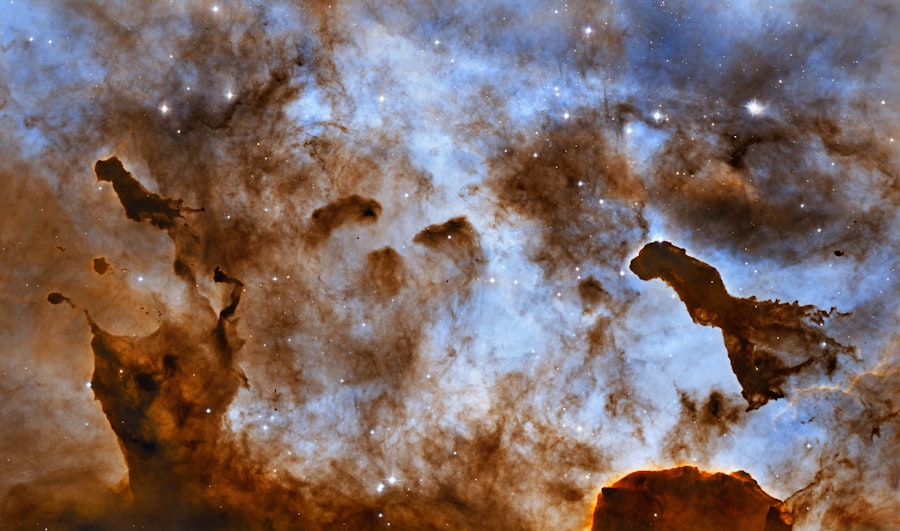In the vast expanse of the universe, a profound and enigmatic phenomenon looms: cosmic darkness. This term encapsulates not only the absence of light but also the inevitable fate that awaits all celestial bodies. As humanity gazes into the night sky, it is met with a tapestry of stars and galaxies, each twinkling point a reminder of the universe’s grandeur.
Yet, beneath this beauty lies a stark reality—an eventual descent into darkness. The cosmos, once vibrant with the light of countless stars, is destined to transform into a cold, desolate void. This article embarks on a journey through the stages of cosmic evolution, exploring the fate of stars and galaxies, the expansion of the universe, and the ultimate demise of all matter.
The concept of cosmic darkness serves as a poignant reminder of the transient nature of existence. Stars, once born from the primordial clouds of gas and dust, shine brightly for millions to billions of years before succumbing to their inevitable end. Galaxies, vast collections of stars, gas, and dark matter, also face a similar fate.
As they age and evolve, they will eventually fade into obscurity. The universe itself is not static; it is a dynamic entity that has been expanding since the Big Bang. This expansion sets the stage for a future where light will become increasingly rare, and darkness will reign supreme.
Understanding this cosmic journey is essential for grasping the fate that awaits not only our own galaxy but the entire universe.
Key Takeaways
- The Cosmic Darkness is a period in the distant future when all stars have exhausted their fuel and the universe is filled with darkness.
- Stars and galaxies will eventually meet their fate as they run out of fuel and cease to shine, leading to a universe devoid of light and energy.
- The universe is expanding at an accelerating rate, causing galaxies to move further apart from each other and leading to a colder and darker future.
- Stellar nucleosynthesis will come to an end as all available fuel is used up, leaving behind only remnants of dead stars and no new elements being formed.
- The era of black holes will dominate the universe as they continue to grow and merge, eventually becoming the primary source of mass and energy.
The Fate of Stars and Galaxies
Stars are born in nebulae, vast clouds of gas and dust that collapse under their own gravity. This process ignites nuclear fusion in their cores, allowing them to shine brightly for eons. However, every star has a life cycle dictated by its mass.
Massive stars burn through their nuclear fuel rapidly, leading to spectacular supernova explosions that scatter elements across the cosmos. In contrast, smaller stars like our Sun have longer lifespans, eventually swelling into red giants before shedding their outer layers and leaving behind white dwarfs. These remnants will cool over billions of years, fading into black dwarfs—cold, dark remnants of their former glory.
Galaxies, too, face an uncertain future. As they collide and merge over cosmic timescales, they undergo significant transformations. The Milky Way, for instance, is on a collision course with the Andromeda Galaxy, an event that will reshape both galaxies in unimaginable ways.
However, even these grand structures are not immune to the effects of cosmic darkness. Over trillions of years, star formation will cease as gas is depleted and stellar remnants dominate the landscape. The once vibrant galaxies will become graveyards of stars, slowly drifting apart as gravitational forces weaken.
This gradual decline marks the beginning of an era where light becomes increasingly scarce.
The Expanding Universe

The universe is in a constant state of expansion, a phenomenon first observed by Edwin Hubble in the early 20th century. This expansion is driven by dark energy, a mysterious force that permeates space and accelerates the separation of galaxies. As galaxies move away from each other, the light they emit becomes redshifted—a shift towards longer wavelengths that signals their increasing distance from observers on Earth.
This expansion not only alters the distribution of galaxies but also affects the fate of individual stars within those galaxies. As the universe continues to expand, it will reach a point where galaxies become so distant that their light will no longer be visible from one another. This isolation will lead to a cosmic landscape dominated by darkness, where only a few stars remain visible in local groupings.
The implications of this expansion are profound; it suggests that the universe is not only growing larger but also becoming increasingly inhospitable to life as we know it.
The End of Stellar Nucleosynthesis
| Element | Abundance in the Universe |
|---|---|
| Hydrogen | 75% |
| Helium | 23% |
| Oxygen | 0.8% |
| Carbon | 0.3% |
| Iron | 0.2% |
Stellar nucleosynthesis is the process by which stars create heavier elements through nuclear fusion in their cores. This process is responsible for producing many of the elements found in nature today, including carbon, oxygen, and iron. However, as stars exhaust their nuclear fuel and enter their final stages of life, nucleosynthesis comes to an end.
For massive stars, this culminates in explosive supernovae that scatter these elements into space, enriching the interstellar medium and allowing for new star formation. Yet this cycle cannot continue indefinitely. As time progresses and star formation rates decline due to gas depletion, fewer new stars will be born to replace those that have died.
The universe will gradually become devoid of the necessary conditions for stellar nucleosynthesis to occur. Without new stars igniting and producing elements through fusion, the cosmos will be left with only remnants—white dwarfs, neutron stars, and black holes—each representing a stage in stellar evolution but lacking the ability to create new elements. This cessation marks a significant turning point in cosmic history; it signifies not just the end of star formation but also a shift towards a universe dominated by dark matter and degenerate remnants.
The Era of Black Holes
As stars reach the end of their life cycles, many collapse under their own gravity to form black holes—regions of spacetime where gravity is so strong that nothing can escape from them. These enigmatic entities are born from the remnants of massive stars after supernova explosions or through the merging of neutron stars. Black holes represent one of the most extreme outcomes of stellar evolution and play a crucial role in shaping the future of the universe.
In the distant future, black holes will become increasingly prevalent as they consume surrounding matter and merge with one another. Over time, they will dominate the cosmic landscape, outnumbering stars and galaxies as stellar remnants fade away. The era of black holes will be characterized by their slow growth and eventual evaporation through Hawking radiation—a theoretical process proposed by physicist Stephen Hawking that suggests black holes can emit radiation due to quantum effects near their event horizons.
This gradual evaporation will lead to a universe where black holes are no longer stable entities but rather transient phenomena that contribute to an ever-decreasing amount of matter in existence.
The Decay of Protons

One of the most profound implications for the future of matter in the universe is the potential decay of protons—a fundamental building block of atomic nuclei. While current theories suggest that protons are stable over incredibly long timescales, some grand unified theories propose that they may eventually decay into lighter particles over billions or even trillions of years. If this decay occurs, it would signify a dramatic shift in the composition of matter itself.
The decay of protons would lead to a gradual disintegration of atomic structures as hydrogen atoms—the most abundant element in the universe—cease to exist. As protons decay into lighter particles such as positrons and neutrinos, ordinary matter would become increasingly rarefied. This process would contribute to an even more desolate cosmic landscape where atoms no longer hold together to form molecules or structures.
The implications are staggering; it suggests that even the fundamental components of matter may not be eternal but rather subject to decay over unimaginable timescales.
The Age of Degenerate Matter
As protons decay and stellar nucleosynthesis comes to an end, the universe will enter an era dominated by degenerate matter—remnants left behind by dead stars such as white dwarfs and neutron stars. These objects represent states of matter under extreme conditions where quantum mechanical effects play a significant role in determining their properties. White dwarfs are composed primarily of electron-degenerate matter while neutron stars consist mainly of neutron-degenerate matter.
In this age of degenerate matter, interactions between particles will become increasingly rare as temperatures drop and densities decrease.
Over trillions of years, even these degenerate objects will cool further until they reach temperatures close to absolute zero—a state where all thermal motion ceases.
The cosmos will be filled with dark remnants scattered across an empty expanse—a stark contrast to its once vibrant past.
The Evaporation of Black Holes
As black holes continue to dominate the cosmic landscape during this era of degenerate matter, they too are not immune to change. According to Hawking’s theory, black holes can emit radiation due to quantum effects near their event horizons—a process known as Hawking radiation. Over incredibly long timescales, this radiation leads to a gradual loss of mass for black holes until they eventually evaporate completely.
The evaporation process is exceedingly slow for large black holes; however, smaller black holes may evaporate more quickly due to their higher surface area-to-volume ratio. As these black holes dissipate into radiation and particles over eons, they contribute further to an increasingly empty universe devoid of significant structures or energy sources. Eventually, all black holes may vanish from existence—leaving behind only faint traces in the form of radiation that permeates space.
The Era of Dark Matter
As ordinary matter fades away and black holes evaporate into nothingness, dark matter will emerge as one of the last remaining components shaping the universe’s fate. Although dark matter remains elusive and undetectable through conventional means, its gravitational influence is evident in galactic formations and cosmic structures. It is believed to make up approximately 27% of the total mass-energy content of the universe.
In this era dominated by dark matter, interactions between particles will become increasingly rare as ordinary matter dissipates into radiation or decays entirely. The gravitational effects exerted by dark matter will continue to influence any remaining structures within the cosmos—albeit on vastly diminished scales compared to earlier epochs when galaxies thrived with vibrant star populations. Ultimately, dark matter may serve as one final remnant holding together what little remains in an otherwise desolate universe.
The Dissolution of Galaxies
As time progresses further into this distant future marked by dark matter dominance and fading remnants from stellar evolution processes like proton decay or black hole evaporation—the dissolution of galaxies becomes inevitable. Once bustling hubs filled with stars engaged in dynamic interactions will gradually succumb to gravitational forces pulling them apart. Galaxies will drift further away from one another due to ongoing cosmic expansion while losing their remaining stellar populations over eons spent in isolation within vast voids devoid of energy sources or new star formation opportunities.
Eventually—after trillions upon trillions years—these once-magnificent structures may dissolve entirely into clouds composed primarily composed solely out dark matter particles drifting aimlessly through an empty expanse.
The Ultimate Fate of the Universe
The ultimate fate awaiting our universe is one steeped in cosmic darkness—a slow march towards entropy where all structures dissolve into nothingness over unimaginable timescales spanning trillions upon trillions years ahead . As ordinary matter fades away alongside its stellar progenitors ,and black holes evaporate into radiation ,the cosmos will be left with only faint echoes from its vibrant past—a cold ,dark void populated solely by remnants like degenerate matter or elusive dark matter particles drifting aimlessly through space . This scenario paints a sobering picture for those who ponder humanity’s place within this grand cosmic tapestry .
Yet it also serves as a reminder that existence itself is fleeting ,and every moment spent gazing at starlit skies carries profound significance . In contemplating these distant futures ,one cannot help but appreciate both beauty inherent within our current reality while acknowledging fragility underlying all things . Ultimately ,the journey through cosmic darkness invites reflection on what it means to exist amidst such vastness—and perhaps inspires deeper connections among those who share this fleeting moment together under starlit skies .
As scientists continue to explore the fate of the universe, many are intrigued by the concept of a dark universe, where stars have burned out and galaxies have drifted apart. For a deeper understanding of this topic, you can read more in the article on Freaky Science, which discusses various theories about the universe’s eventual decline into darkness. Check it out here: Freaky Science.
WATCH THIS! The Universe Will Die In Silence. This Is The Googol Year Timeline.
FAQs
What is the “dark universe”?
The “dark universe” refers to the future state of the universe when all the stars have burned out, and there are no more sources of light or energy.
How long until the universe is dark?
It is estimated that the universe will become dark in about 100 trillion years, as all the stars will have exhausted their fuel and ceased to shine.
What will happen when the universe is dark?
When the universe is dark, all the stars will have burned out, and there will be no more sources of light or energy. The universe will continue to expand, and the remaining matter will eventually become cold and lifeless.
What is the fate of the universe after it becomes dark?
After the universe becomes dark, it is theorized that it will continue to expand and eventually reach a state of maximum entropy, where all energy is evenly distributed and no more work can be extracted from it. This state is known as the “heat death” of the universe.
